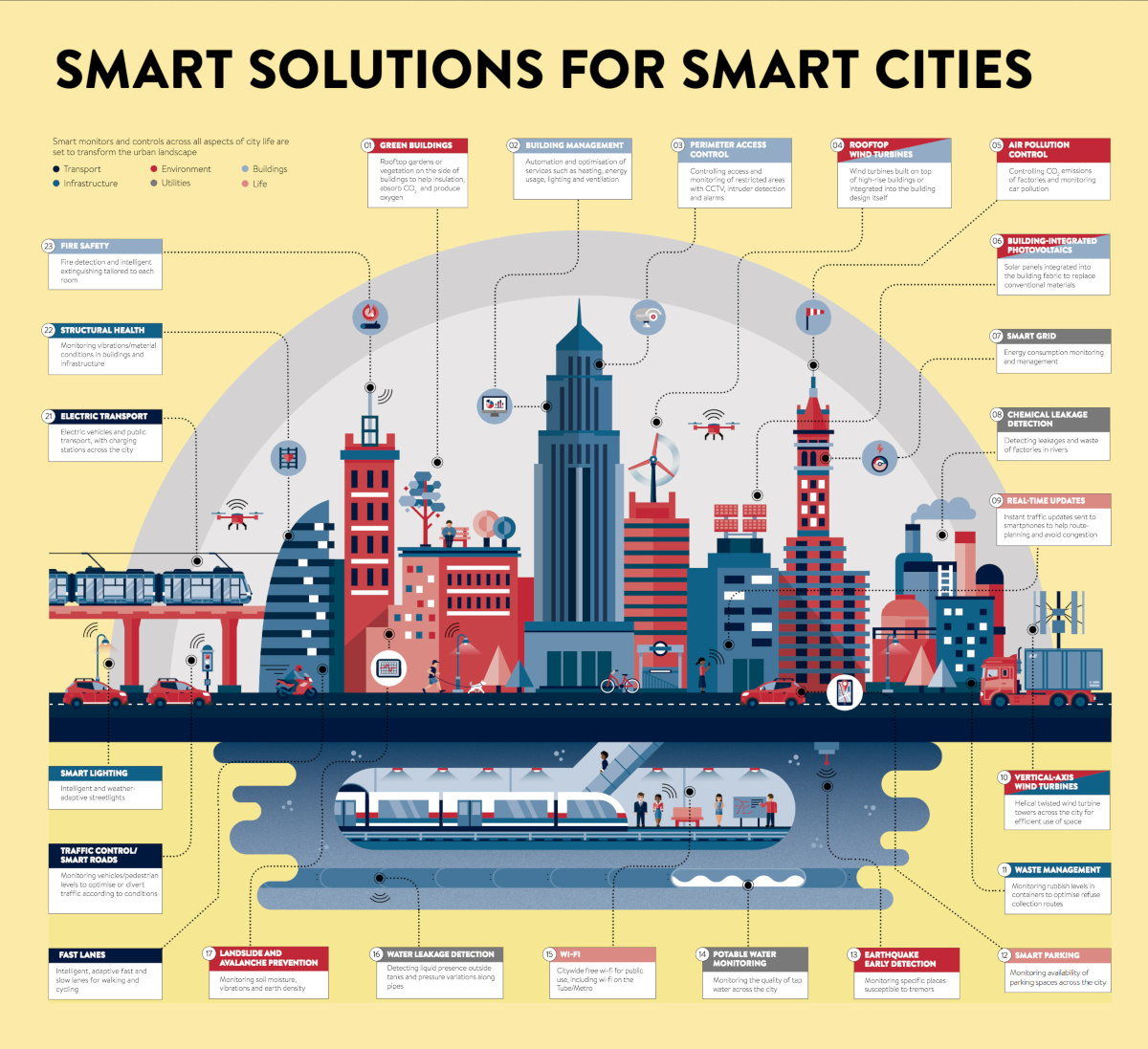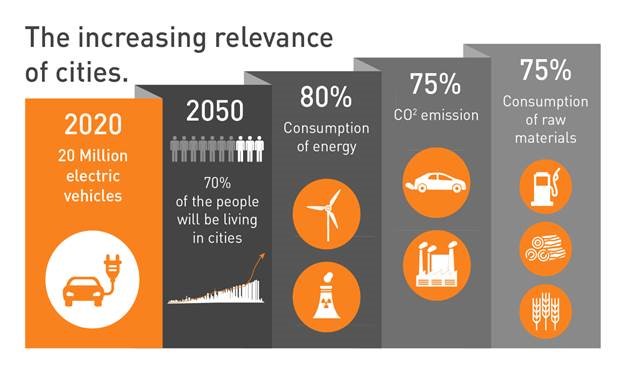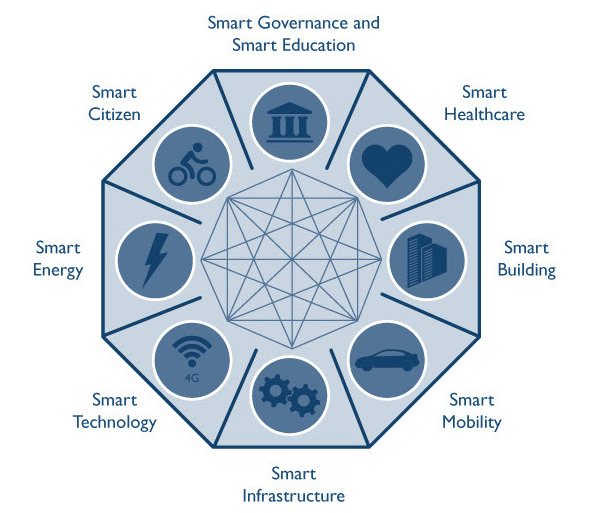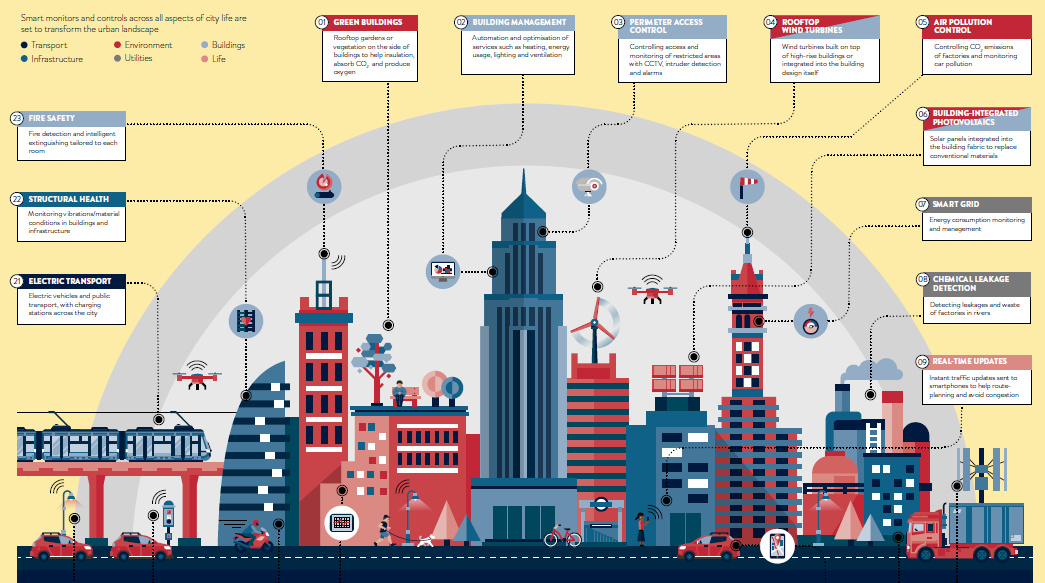Technology
How the World’s Smartest Cities are Being Built
View a high resolution version of this graphic

How the World’s Smartest Cities are Being Built
View the high resolution version of today’s graphic by clicking here.
As the world’s biggest cities continue to sprawl with many millions of new people, they’ll look to many of the technologies and tactics covered in today’s infographic from Raconteur to work smarter – and not harder – for their inhabitants.
Why Cities?
Cities are the engines of modern society.
They power the global economy, consume vast amounts of resources, house the majority of the world’s population, and create much of the pollution and emissions that have scientists concerned about the future.

And while big cities consume a lot of resources already – this hardly compares to the megacities of the near-future. In fact, in our lifetimes, we will see massive urban areas in Africa and Asia with populations that swell to 50 million people or more.
That’s right – there will be swelling urban populations that consume more food, energy, and materials than most countries.
The Right Timing
While the prospect of optimizing for the problems of burgeoning metropolises may seem daunting, the timing is actually perfect. The arrival of the Internet of Things (IoT) – thanks to innovations in cheap sensor technology, big data, and predictive analytics – is making it possible to tackle all sorts of urban issues.
Integrating this, along with other advancements in information communication technology (ICT), into urban planning is the vision for smart cities:

But, enough on the broad strokes of this movement – here’s how specific changes are taking place.
Working Smarter, Not Harder
Here are some of the initiatives taken on by the people running the smartest cities today:
Smart roads
Monitoring vehicle and pedestrian levels to optimize or divert traffic according to conditions. Intelligent, adaptive fast and slow lanes for walking and cycling.
Smart buildings
Rooftop gardens or vegetation on sides of buildings to help with insulation. Optimization of heating, energy usage, lighting, and ventilation. Integrating photovoltaics and wind turbines into building designs.
Smart lighting
Intelligent and weather adaptive street lights to boost energy efficiency.
Smart waste management
Monitoring garbage levels in containers in real-time to optimize collection routes.
Smart grids
Energy consumption monitoring and management. Uses tech to detect and react to local changes in usage.
And cities aren’t the only thing becoming smarter. See how the home is becoming smarter, as well.
Technology
Visualizing AI Patents by Country
See which countries have been granted the most AI patents each year, from 2012 to 2022.

Visualizing AI Patents by Country
This was originally posted on our Voronoi app. Download the app for free on iOS or Android and discover incredible data-driven charts from a variety of trusted sources.
This infographic shows the number of AI-related patents granted each year from 2010 to 2022 (latest data available). These figures come from the Center for Security and Emerging Technology (CSET), accessed via Stanford University’s 2024 AI Index Report.
From this data, we can see that China first overtook the U.S. in 2013. Since then, the country has seen enormous growth in the number of AI patents granted each year.
| Year | China | EU and UK | U.S. | RoW | Global Total |
|---|---|---|---|---|---|
| 2010 | 307 | 137 | 984 | 571 | 1,999 |
| 2011 | 516 | 129 | 980 | 581 | 2,206 |
| 2012 | 926 | 112 | 950 | 660 | 2,648 |
| 2013 | 1,035 | 91 | 970 | 627 | 2,723 |
| 2014 | 1,278 | 97 | 1,078 | 667 | 3,120 |
| 2015 | 1,721 | 110 | 1,135 | 539 | 3,505 |
| 2016 | 1,621 | 128 | 1,298 | 714 | 3,761 |
| 2017 | 2,428 | 144 | 1,489 | 1,075 | 5,136 |
| 2018 | 4,741 | 155 | 1,674 | 1,574 | 8,144 |
| 2019 | 9,530 | 322 | 3,211 | 2,720 | 15,783 |
| 2020 | 13,071 | 406 | 5,441 | 4,455 | 23,373 |
| 2021 | 21,907 | 623 | 8,219 | 7,519 | 38,268 |
| 2022 | 35,315 | 1,173 | 12,077 | 13,699 | 62,264 |
In 2022, China was granted more patents than every other country combined.
While this suggests that the country is very active in researching the field of artificial intelligence, it doesn’t necessarily mean that China is the farthest in terms of capability.
Key Facts About AI Patents
According to CSET, AI patents relate to mathematical relationships and algorithms, which are considered abstract ideas under patent law. They can also have different meaning, depending on where they are filed.
In the U.S., AI patenting is concentrated amongst large companies including IBM, Microsoft, and Google. On the other hand, AI patenting in China is more distributed across government organizations, universities, and tech firms (e.g. Tencent).
In terms of focus area, China’s patents are typically related to computer vision, a field of AI that enables computers and systems to interpret visual data and inputs. Meanwhile America’s efforts are more evenly distributed across research fields.
Learn More About AI From Visual Capitalist
If you want to see more data visualizations on artificial intelligence, check out this graphic that shows which job departments will be impacted by AI the most.
-

 Mining1 week ago
Mining1 week agoGold vs. S&P 500: Which Has Grown More Over Five Years?
-

 Markets2 weeks ago
Markets2 weeks agoRanked: The Most Valuable Housing Markets in America
-

 Money2 weeks ago
Money2 weeks agoWhich States Have the Highest Minimum Wage in America?
-

 AI2 weeks ago
AI2 weeks agoRanked: Semiconductor Companies by Industry Revenue Share
-

 Markets2 weeks ago
Markets2 weeks agoRanked: The World’s Top Flight Routes, by Revenue
-

 Countries2 weeks ago
Countries2 weeks agoPopulation Projections: The World’s 6 Largest Countries in 2075
-

 Markets2 weeks ago
Markets2 weeks agoThe Top 10 States by Real GDP Growth in 2023
-

 Demographics2 weeks ago
Demographics2 weeks agoThe Smallest Gender Wage Gaps in OECD Countries














